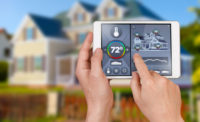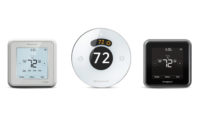The Internet of Things (IoT) has been touted as the “next big thing.”
That prediction has largely come to pass, as the IoT is now a massive part of the marketplace, and manufacturers are consistently finding new and exciting ways to develop and enhance traditional products per the desires of tech-savvy consumers in both the residential and commercial HVAC segments.
“Demand for connectivity from consumers and building owners has grown immensely over the past few years,” said Kevin Miskewicz, director of commercial marketing, Mitsubishi Electric US Inc. Cooling & Heating division. “On the commercial side, we are seeing the integration of several different building functions on smart platforms as well as a rise in building owners and managers condensing all their management needs, such as HVAC, occupant billing, and water metering into one control system. On the residential side, we are seeing growth in homeowner demand for remote control of their systems, specifically through phone- or tablet-based apps.”
According to Siva Ayer, connected home program manager, Carrier Corp., one of the key developments in the IoT has been the sheer number of companies producing products to keep pace with their competition.
“The most exciting developments lay ahead of us,” said Ayer. The industry is working to truly gather and harness the power of distributed data and combine it with other existing data elements and analysis to provide added value to dealers and homeowners,” said Ayer. “Essentially, this will make data actionable, allowing the home to better predict the needs of its occupants and provide preemptive maintenance and service.”
CHANGES ARE COMING
Even as manufacturers reflect on the massive changes that have shaped the landscape of the IoT in recent years, they must also stay abreast of what is just over the horizon. Most agree that major changes will continue to permeate the HVAC industry throughout the next year and beyond.
“As IoT technology advances and becomes more available and more cost-effective, a greater number of devices will be connected throughout buildings,” said Matt Gates, director of intelligent services offers for Trane North America. “This type of interconnectedness will become a way of life in everything we do.”
Jacob Nielson, platform leader, HVAC monitoring, Emerson Climate Technologies Inc., said the company has always been convinced the world will continue to become more open and connected.
“As new technologies continue to emerge, we’re also committed to supporting an open application programming interface (API) that allows customers to control IoT-enabled solutions like our Sensi™ WiFi thermostat through a variety of home automation platforms,” he said.
Dave Molin, vice president of controls, Trane, also mentioned that while the industry is coalescing around a few standard platforms, it’s still too early to say which platform will become the prevalent, standard technology.
“That’s why Trane is an advocate of open and standard protocols for building systems,” he said. “Our equipment and solutions use open and standard protocols — whether it’s IP, BACnet, Lon, or ZigBee — which helps drive value for building owners.”
In the next year, Mitsubishi Electric anticipates providing more internet-enabled offerings to its customers.
“We’ve already rolled out light-commercial compatibility for our kumo cloud remote control app, which represents a shift in audience,” said Miskewicz. “A product that was originally exclusive to homeowners is now also available to building managers. This is a great control option for student housing or small office buildings, which have several different tenants that can be separated by floors, rooms, or zones. We also anticipate other manufacturers will begin integrating open source software into their IoT products. Mitsubishi Electric wants to be a conduit, not a barrier, which is why we use Tridium’s NiagaraAX Framework within our commercial building automation controls. An open source controls architecture is the direction we see the market moving in order for manufacturers to stay current and in the game.”
IN THE CLOUD
The cloud is another aspect of the IoT that has gained a lot of traction in recent years. Cloud storage, including private, public, and hybrid clouds, is predicted to crest at $200 billion by 2018.
This storage is not limited to HVAC, but the data shows the massive scale that cloud storage is now working with.
“I see a lot of systems going to more cloud-based platforms,” said Josiah Wiley, director of development and engineering at Ruskin Co. “It used to be that you had to have a computer running in the facility with the main server application running at that site. Now, we are seeing a push toward cloud-based building control systems on the horizon. We also see intelligence being pushed into actuators for control dampers and light safety actuators. So, instead of having to have third-party panels with controls that control that product, communication will go right into the actuator, which eliminates the control panel and allows digital communication.”
DEALING WITH DEMAND
The growth of IoT and its developments cannot be overstated, but with all the investments of time, research, and money that manufacturers are putting in, they must ensure the demand and fervor for these smart products remains after their products hit the market.
Jeff Underwood, marketing vice president, Goodman Mfg. Co. business unit, said demand is increasing rapidly as technology firms are launching both hardware and software products in the marketplace. “As IoT devices become more available and homeowners become more comfortable, the growth rate should continue as long as the price of the system remains competitive,” he said.
“On one hand, I see the hype coming down-to-earth as manufacturers have realized that end users will not pay for certain predictive maintenance capabilities,” said Jonathan Holloway, strategic marketing director, Danfoss. “But, at the same time, new technologies focused on solving real problems keep coming to market. The residential smart thermostat market continues to grow with support from utilities. On the commercial side, traditionally connected applications, like food retail and chillers, are getting deeper into extracting value from data. While tenant/owner split incentive hurdles make spreading IoT capabilities into other commercial HVACR applications more difficult, new financing models are making deep retrofits with smart systems possible.”
I think customers are still learning about the IoT-enabled solutions that are available and considering how those solutions can provide value to their bottom lines, said Gates.
“While interest in IoT on the residential side has led the way, more customers are realizing they also have many IoT options on the commercial side, so I believe more demand is on the way,” added Gates. “To meet that demand, Trane is working to increase its solutions and offerings to meet customer needs. One example of that is the company’s advanced analytics and predictive services.”
Wiley said he believes demand for IoT-enabled products is only breaking the surface. “As technology is advancing and devices are becoming smarter, people are expecting to have devices that reflect that growth,” he said. “I anticipate IoT-enabled devices within the industry will continue to be in demand. In HVAC, we have a large roadmap for increasing smart devices.”
In order to keep up with users in both commercial and residential segments, Mitsubishi Electric has to constantly meet and exceed the demands in technological advancements, said Miskewicz.
“User demand for IoT compatibility grows every day, because IoT-enabled products make life easier,” he said. “That’s enough for us to bring new products and advancements to the table and include IoT connectivity in all of our product devel-
opment discussions.”
THE IOT IS FOR EVERYONE
One common misconception surrounding the IoT is that it’s just for younger consumers. Instead, consumers of all ages are embracing and using smart products.
“Everyone wants to do a better job and be more efficient with their time,” said Saar Yoskovitz, CEO and cofounder, Augury Systems. “Older and younger generations are both open to new technologies.”
Nielson said it’s directionally true that younger homeowners are more interested in the IoT, but has seen that IoT customers can be segmented in more ways than just age/generation. “Our marketing strategies center on the psychographics of our target audience as much as, if not more than, demographics, like age, gender, income, and so on,” he said. “IoT products tend to have a strong appeal for a certain type of lifestyle or consumer mindset. For some, it’s simply about convenience and aesthetics, while for others it’s more about comfort and peace of mind. When we segment the market along those dimensions, we do see a lot of cross-generational customer profiles.”
“Millennials are the early adopters for certain kinds of IoT-enabled products, like smartphones and smart TVs,” said Miskewicz. “For our products, we’re actually seeing a larger presence of Gen-Xers who are willing to invest in smart, efficient, and connected homes. They have the purchasing power when it comes to long-term investments, like smart refrigerators, solar panels, and other smart technologies for their homes. Of course, all consumers want products that will improve the way they live, but when it comes to cooling and heating systems, we in the industry are more often than not speaking to 35- to 50-year-old homeowners who are willing to invest in smart home environments.”
Wiley agreed that younger consumers are jumping at the chance to use smart devices more than their older counterparts. “However, at the same time, you will see people who have been around this industry for a while who want to be able to have those systems tied into smart devices,” he said. “Younger people almost expect to be able to interact with their devices, and we will continue to see that desire for IoT-enabled products increase across the board.”
Underwood pointed out that interest and willingness to pay are two different issues. “While younger homeowners have different expectations for interacting with electronics, including HVAC systems and thermostats, they often are unwilling to make the necessary financial investment to unlock IoT features,” he said. “We believe we need to find better ways to enable IoT-style integration and control into base efficiency products to help younger consumers get the products they can afford with the features they expect. That said, there is a subset of older homeowners who can make the financial investment but might shy away, currently, from the technology. But, many older homeowners are fully comfortable with advancing technology and will embrace IoT devices and systems just as they have with other advances, such as smartphones, smart televisions, and other household appliances.”
THE SECURITY HURDLE
There have also been security concerns that have echoed throughout the IoT since its inception. Some consumers are naturally skeptical of new technologies, but as the IoT has proven itself to be a long-term piece of the HVAC puzzle, those worries are lessening.
“There are some basic things users can do to minimize their risks, including recognizing spear-phishing emails and avoiding password reuse,” said Miskewicz. “Secure password managers are great tools for encouraging the use of complex, unique passwords. However, even the most vigilant users are still largely reliant upon the systems they interact with to protect their data. To that end, users should select and use products from companies they trust.”
Wiley said security concerns regarding the IoT have gone down, and you will see a lot of controls manufacturers add security protocols to control systems. “Johnson Controls, which owns Ruskin, has an entire network security team for building controls, and it just procured a business relationship with the National Security Agency for building control security,” he said. “This will grant ease of access to the building communications for those HVAC products with the security in place to protect that system. As controls companies have looked at increasing the security of those networks, we are seeing more people willing to accept it.”
Nielson said customers are still concerned about security, but there is a general shift in opinion among the younger generation. “They seem to be more open and accepting of these additional connected devices in their homes,” he said. “Though, regardless of age, I think it’s safe to say security will remain an important consideration for most customers for the foreseeable future.”
Publication date: 12/12/2016
Want more HVAC industry news and information? Join The NEWS on Facebook, Twitter, and LinkedIn today!






Report Abusive Comment